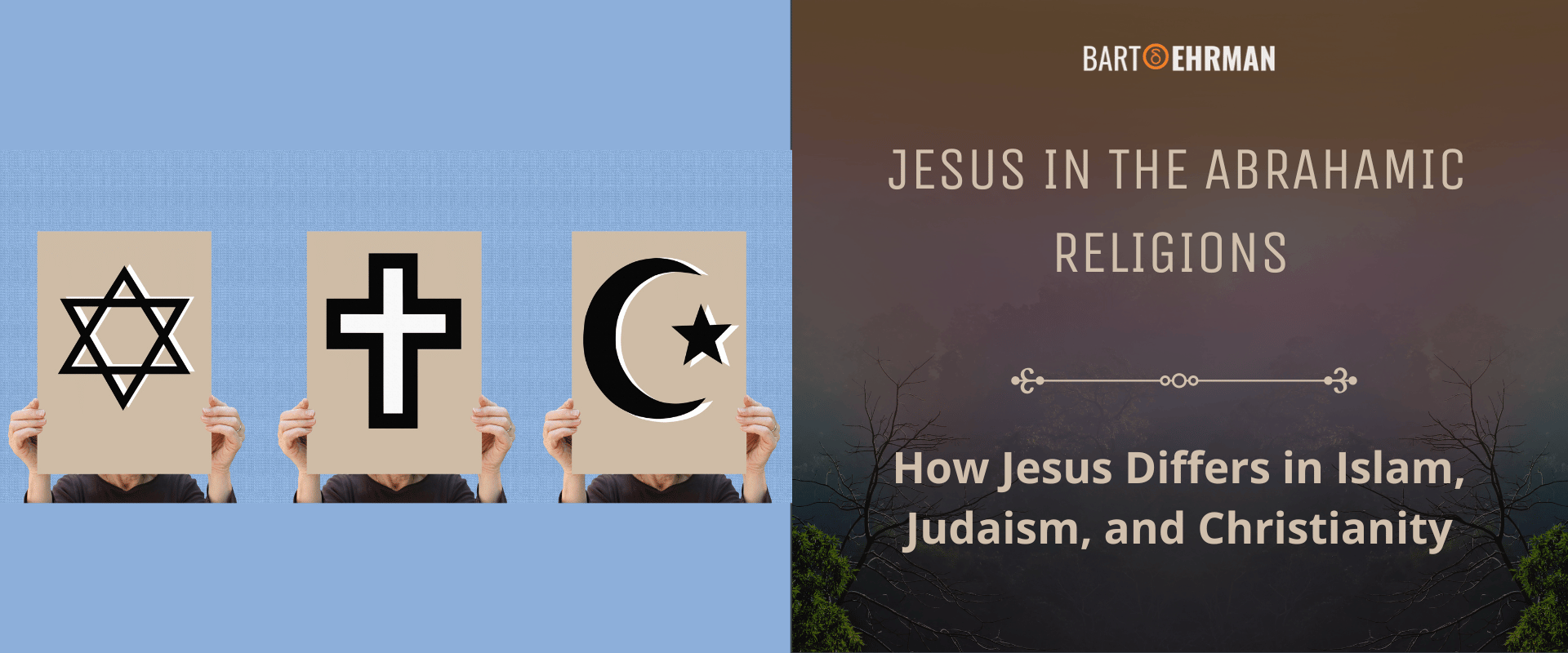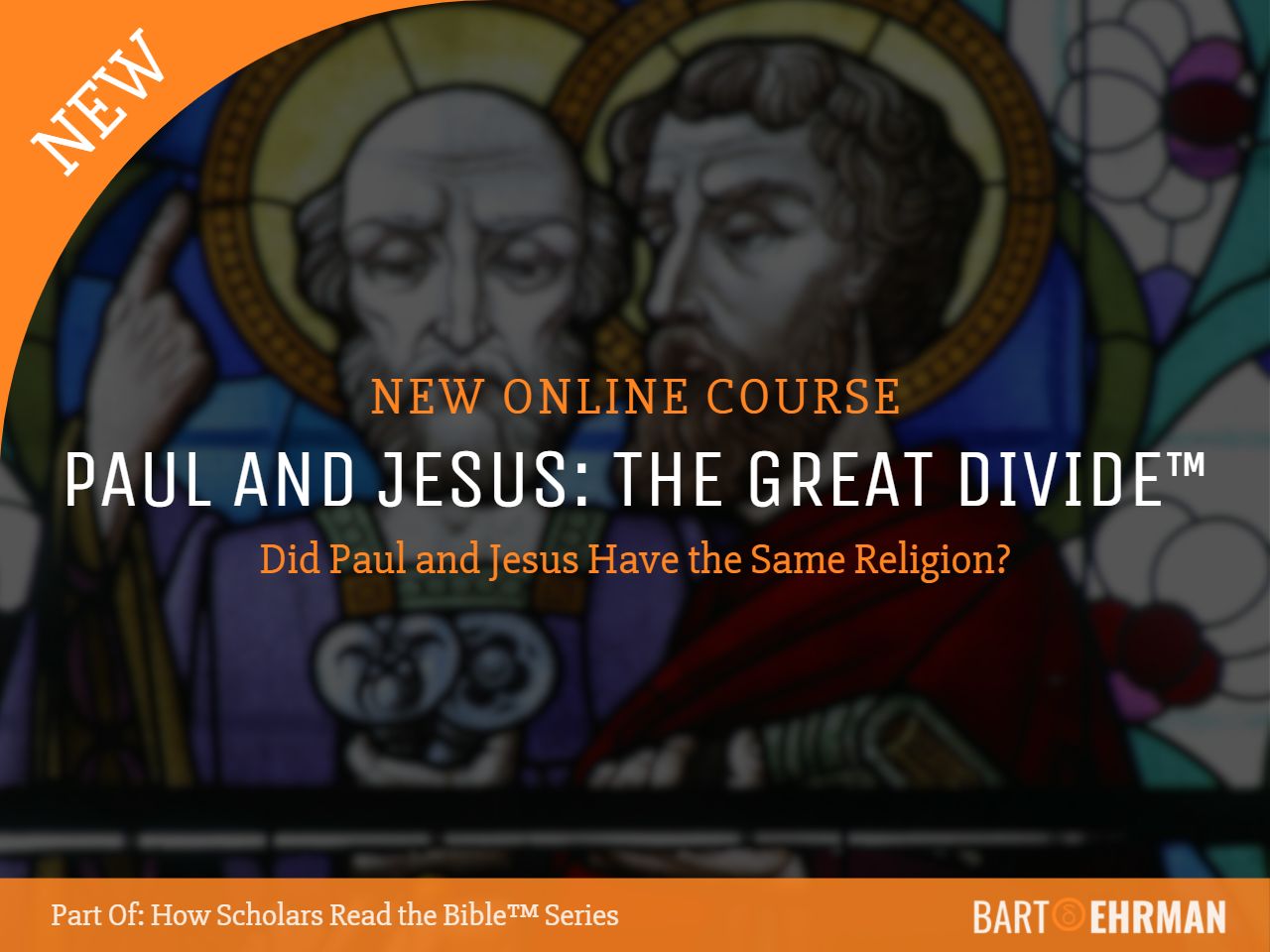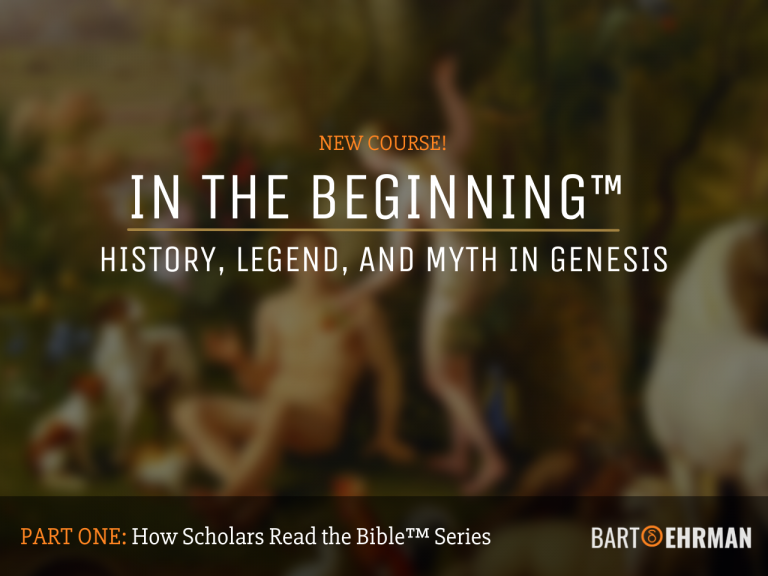How Jesus Differs in Islam, Judaism, and Christian Beliefs

Written by Marko Marina, Ph.D.
Author | Historian
Author | Historian | BE Contributor
Verified! See our guidelines
Verified! See our editorial guidelines
Date written: January 25th, 2024
Edited by Laura Robinson, Ph.D.
Disclaimer: The views and opinions expressed in this article belong to the author and do not necessarily match my own. - Dr. Bart D. Ehrman
In "Who's Bigger?: Where Historical Figures Really Rank", authors Steven Skiena and Charles Ward undertook the ambitious task of quantifying the impact of historical figures. Their analysis positioned Jesus as the most influential person in history.
This ranking underscores the profound significance of Jesus not only as a religious icon but also as a central figure in the tapestry of Western civilization.
Today, Jesus remains at the heart of Christianity, the religion of over two billion followers globally. His life, teachings, and legacy continue to shape not only religious thought but also cultural, ethical, and social paradigms.
However, the perception and interpretation of Jesus vary significantly across different cultural and religious contexts. In the Judaic tradition, he is viewed through a different lens than in Christianity, and similarly, Islamic texts offer a distinct portrayal of Jesus that diverges from both Christian and Jewish perspectives.
This article aims to explore how Jesus differs in Islam, Judaism, and Christian beliefs. Our objective is not to engage in theological debate or endorse any religious viewpoint, but rather to examine how different traditions have historically understood and represented Jesus.
By adopting this approach, we aim to provide an objective analysis, focusing on how each tradition situates Jesus within its historical narrative. Moreover, our focus isn’t a scholarly (historical) reconstruction of Jesus’ life - to know more about that check out a couple of our earlier articles (here, and here).
This methodological choice allows us to delve into the nuances of these portrayals while maintaining scholarly objectivity and accessibility to readers regardless of their religious backgrounds.
Interested in further historical exploration? Join Bible scholar Dr. Bart Ehrman in his enlightening online course, 'In the Beginning: History, Legend, or Myth in Genesis?' Dive into six 30-minute lessons for an in-depth understanding of the Book of Genesis from a historical perspective.
Let’s begin by exploring how Judaism is different from Christianity. To do that, we need to get back to the historical context of Jesus’ life!

Jesus in Judaism: Historical Context and Collective Memory
The portrayal of Jesus in Jewish tradition diverges significantly from the Christian and Islamic perspectives, emphasizing his roots as a Jewish figure. As noted by scholars Tom Holmen and Stanley Porter, "Jesus’ Jewish roots and relations have long been an essential item of discussion and contention in historical Jesus studies.”
Within the framework of Judaism, particularly during the Second Temple period, the environment was ripe with various religious and philosophical thoughts under the shadow of Roman rule.
This era, marked by the presence of diverse Jewish sects like the Pharisees, Sadducees, Essenes, and Zealots, presented a complex religious tapestry. Each group had its interpretation of Jewish law and tradition, reflecting the multifaceted nature of Judaism at the time.
Another significant aspect of Jewish thought during this period was apocalypticism. Many Jewish groups, influenced by the socio-political pressures of Roman occupation and internal religious debates, fostered a belief in an imminent end of the world.
This belief system, characterized by the anticipation of a messianic figure and a transformative end of the current age, provides context for understanding some of the Jewish expectations and interpretations of Jesus' time.
In this milieu, Jesus emerges as a figure within the Judaic tradition, yet one whose portrayal is marked by distinct nuances and interpretations.
Unlike the Christian view of Jesus as the divine Messiah and the Islamic recognition of him as a prophet, Jewish texts typically regard Jesus as a historical figure whose life and teachings must be understood within the broader context of Jewish history and thought.
Transitioning from this understanding, we will now explore the specific Jewish texts and rabbinic sources to further illuminate the Judaic view of Jesus and his place within Jewish tradition.
Jesus in the Rabbinic Sources: Magician, not a Messiah!
In Jewish tradition, the portrayal of Jesus is strikingly different from the narratives found in Christian and Islamic texts. The Rabbinic sources, particularly the Talmud, offer limited but intriguing references to Jesus, providing a glimpse into the Jewish perspective on his life and identity.
The Talmudic references to Jesus are sparse and cryptic, often embedded in layered narratives and allegories. These references do not provide a comprehensive biography but rather snippets that reflect the complex relationship between early Rabbinic Judaism and the emerging Christian movement.
Did You Know?
In Islamic tradition, there's a beautiful and thought-provoking parable involving Jesus (Isa), which is often recounted for its moral and spiritual teachings. According to this parable, Jesus once passed by an olive tree and addressed it, saying, "Speak to me, O Olive Tree!" The olive tree responded, "Peace be upon you, O Prophet of God. You are welcome. What do you want from me?"
Jesus then asked the tree, "What is the best thing you have?" The olive tree replied, "The best thing I have is that I provide oil that lights up lamps, nourishes bodies, and acts as a remedy for the sick.
One of the most contentious aspects of the Talmud's portrayal of Jesus is the suggestion of his illegitimate birth, famously encapsulated in the Panthera theory. This theory posits that Jesus was the son of a Roman soldier named Panthera, challenging the Christian narrative of the virgin birth.
Such a portrayal reflects a broader skepticism within the Jewish tradition about the divine claims made about Jesus, aligning more with a view of him as a historical figure rather than a theological one.
Moreover, the Talmud presents Jesus and his followers as practitioners of magic. The most famous example is the story of R. Yehoshua b. Levi and his grandson who was healed by some anonymous heretic, a follower of Jesus. However, as the story goes, the grandson may survived but lost his life in the world to come because he received help from a heretical magician.
As Peter Schäfer explains: “The story about Yehoshua b. Levi and his Grandson is not just an affirmation of the automatic effectiveness of magic; rather, it presents an ironical critique of Jesus’ and his followers’ belief in their magical power… Hence, our story ultimately conveys the message: this Jesus and his followers claim to have the keys to heaven, to use their magical power with divine authorization—but they are dead wrong!
Is Jesus Messiah in Judaism? The Jewish concept of the Messiah, as John J. Collins shows, differs significantly from the Christian interpretation. In the context of Second Temple Judaism, the concept of the Messiah was multifaceted and varied among different Jewish groups:
However, these diverse Messianic expectations shared a common thread – they didn’t foresee the Messiah as an obscure preacher from Nazareth who would suffer a criminal's death on the cross. As a result, the figure of Jesus, with his humble origins and humiliating death, starkly contrasted with the prevailing Jewish notions of a Messiah.
This incongruity led to the predominant Jewish rejection of Jesus' claim to Messianic identity, as he didn’t align with any of the anticipated Messianic archetypes prevalent in Jewish thought at the time.
Moreover, the Talmud also touches upon the death of Jesus. The text alludes to Jesus being executed, a detail that aligns with the Christian narrative of the crucifixion:
“On Passover Eve they hung the corpse of Jesus the Nazarene after they killed him by way of stoning. And a crier went out before him for forty days, publicly proclaiming: Jesus the Nazarene is going out to be stoned because he practiced sorcery, incited people to idol worship, and led the Jewish people astray.” (Sanhedrin 43a).
Here it’s important to note that Judaism doesn’t accept the belief in the redemptive nature of Jesus’ death. In Jewish tradition, his death is explained as the execution of a controversial figure in Jewish society at the time.
Having explored the view of Jesus within Jewish tradition, we now transition to examining his portrayal in the Christian tradition, where he occupies a central and defining role that shapes the very foundation of the faith.
Jesus in the Christian Tradition: The Resurrected Messiah, Son of God, and the Savior
Christianity, as a distinct religious movement, did not emerge immediately with the life or even the death of Jesus, but rather, as Dr. Bart Ehrman has shown, with the belief in his resurrection. This pivotal event marks the foundational moment in Christian history, signifying the start of the transition from a Jewish sect to a separate and distinct religion.
The resurrection of Jesus is seen as a confirmation of his divine mission and a cornerstone of Christian belief, catalyzing the spread of Christianity beyond its Jewish roots.
In the early centuries of Christianity, there was a diversity of beliefs and perspectives about Jesus among various Christian communities. This pluralism is vividly depicted in Bart Ehrman's "Lost Christianities", which explores the rich tapestry of early Christian thought. Over time, one perspective gradually gained predominance, forming the basis of what is now known as mainstream Christian belief.
Central to this mainstream Christian view is the conception of Jesus as the incarnated Son of God, simultaneously fully divine and fully human.
This dual nature of Jesus was a subject of extensive theological debate in the early Church. The Council of Chalcedon in 451 C.E. played a crucial role in affirming this doctrine, asserting that Jesus was to be acknowledged in two natures, without confusion, change, division, or separation.
Furthermore, the Christian portrayal of Jesus emphasizes his redemptive death – his crucifixion isn’t seen just as a historical event but as a sacrificial act for the salvation of humanity. His resurrection is celebrated as the victory over death and sin, opening the path to eternal life for all who embrace his teachings and accept him as their Savior.
This mainstream Christian understanding of Jesus, however, didn’t emerge in a vacuum. It was shaped by and in response to the diverse theological landscapes of the time, including various interpretations of Jesus' nature and mission.
The debates and discussions that occurred within the early Christian community were instrumental in shaping the orthodox doctrines that would come to define Christianity.
Shifting our attention from the Christian understanding, we next delve into the Islamic perspective on Jesus. This viewpoint, distinct yet respectful, adds another layer to our exploration of how different traditions perceive this seminal figure in history. Let’s take a look at how is Islam different from Christianity!
Jesus in Islam: A Great Prophet?
Islam's emergence is intrinsically linked to the life of Prophet Muhammad (570-632 CE), whose role vastly differed from that of Jesus. Muhammad wasn’t only a religious figure but also a political leader and military commander. His multifaceted role played a crucial part in shaping the early Islamic community, which was both a religious and a political entity.
The distinct identity of Islam, as highlighted in Fred M. Donner's study "Muhammad and the Believers," developed over the first 200 years following Muhammad's death, during which time the Islamic community transitioned from the “Monotheistic renewal movement” centered around a charismatic leader to a distinct religion that conquered a huge territory encompassing Arabic peninsula, the Middle East and North Africa.
To understand the Islamic portrayal of Jesus, it's essential to first define the Quran. The Quran is the holy book of Islam, believed by Muslims to be the word of God as revealed to Muhammad.

Jesus in the Quran
Within the Quran, Jesus, known as Isa, is mentioned numerous times, often in the context of stories about his mother, Mary (Maryam in Arabic). Oddbjorn Leirvik explains:
“The Christ story isn’t retold in the Quran, only referred to. Furthermore, many of the references to Christ are found within a context where Mary is the dominant figure. The title of Surah 3 is ‘The House of Imran' (the fatherhouse of Mary according to the Quran) and that of Surah 19 is ‘Maryam’. Most of the references to Christ are found in these suras.”
For instance, Surah (chapter) 19 extensively discusses the birth of Jesus, emphasizing his miraculous nature from the outset.
It’s essential to note that throughout Surah 19, the narrative of Jesus' birth and early miracles serves to reinforce the message of monotheism. Jesus, even as an infant, is depicted as a human messenger who calls people to worship one God and follow the path of righteousness.
Jesus in the Early Islamic Tradition
The Hadiths, a collection of sayings and actions of Prophet Muhammad, also provide insights into the Islamic view of Jesus. While the Hadiths are secondary to the Quran, they offer additional context and interpretation of Islamic teachings. The Hadiths include references to Jesus, primarily regarding his return at the end of times.
According to various Hadiths, Jesus will descend at a time when the world is filled with injustice and conflict. A well-known Hadith narrated by Abu Huraira, found in Sahih Bukhari (one of the most authentic collections of Hadith), states:
"By Him in Whose Hands my soul is, surely (Jesus,) the son of Mary will soon descend amongst you and will judge mankind justly (as a Just Ruler); he will break the Cross and kill the pigs and there will be no Jizya (i.e. taxation taken from non-Muslims). Money will be in abundance so that nobody will accept it, and a single prostration to Allah (in prayer) will be better than the whole world and whatever is in it.”
Furthermore, one of the earliest biographies (c. 760. C.E.) recorded the letter that Muhammad sent to the Christian Negus of Abyssinia. In it, he states:
“I bear witness that Jesus son of Mary is the spirit of God and His word which he cast to Mary the Virgin, the good, the pure so that she conceived Jesus. God created him from His spirit and His breathing as He created Adam by His hand and His breathing.”
In Islam, therefore, Jesus (Isa) is revered as a prophet and a messenger of God, but not as divine. This stands in contrast to the Christian view of Jesus as the incarnation of God. Another fundamental divergence from Christian belief is the Islamic assertion that Jesus wasn’t crucified.
The Quran states that it appeared to people that Jesus was crucified, but in reality, he wasn’t, and God raised him to Himself. This belief negates the concept of Jesus' redemptive death, a cornerstone of Christian religion.
Moreover, the Islamic narrative also dismisses the idea of original sin and the need for atonement through Jesus' sacrifice, emphasizing instead the concepts of personal responsibility and accountability before God. The portrayal of Jesus in Islam is one of a human being, a mighty prophet, who, like others before him, came to guide humanity towards monotheism and righteous living.
As we approach the end of our exploration, let’s take a look at the table summarizing the key differences in the views of Judaism, Christianity, and Islam on Jesus.
Question | Judaism | Christianity | Islam |
|---|---|---|---|
Did Jesus Exist? | Yes | Yes | Yes |
Was He Messiah? | No | Yes, as Christ | Yes, but not in the Christian sense |
Was He Divine? | No | Yes, fully divine and fully human | No, “just” a great prophet of God |
Did He Die on the Cross? | Yes | Yes | No, he was taken up to God |
Did He Rise After His Death? | No | Yes | No |
His Role in End Times? | Not involved (focuses on the coming of a future Messiah) | Second Coming - central to Christian eschatology | Will return to restore justice |
Summing up Conclusions: Different Views on Jesus
In this exploration of how Jesus differs in Islam, Judaism, and Christian beliefs, we have encountered a figure of profound complexity and multifaceted significance. Jesus, a historical figure whose existence is acknowledged across these major world religions, is viewed through remarkably different lenses.
For Christianity, Jesus is the divine Messiah, whose life, death, and resurrection form the cornerstone of the religion's belief in salvation and redemption. Judaism, while recognizing Jesus as a historical figure, doesn’t ascribe to him a messianic or divine status, reflecting a starkly different interpretation of his role and legacy.
Islam reveres Jesus as a mighty prophet and the Messiah, yet denies his divinity and crucifixion, offering a narrative that intertwines respect and distinction.
The differing perspectives on Jesus – from his nature to his role in eschatology – serve as a fascinating reflection of the broader dialogues and interactions among these religions throughout history.


